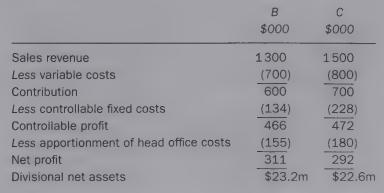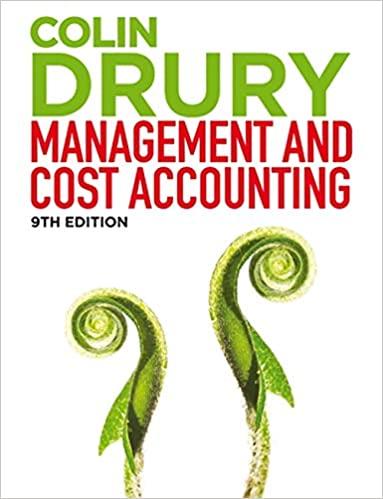Advanced: Calculation of ROI and RI and conflict between NPV and performance measurement. The Biscuits division (Division
Question:
Advanced: Calculation of ROI and RI and conflict between NPV and performance measurement. The Biscuits division (Division B) and the Cakes division (Division C) are two divisions of a large, manufacturing company. While both divisions operate in almost identical markets, each division operates separately as an investment centre. Each month, operating statements must be prepared by each division and these are used as a basis for performance measurement for the divisions.
Last month, senior management decided to recharge head office costs to the divisions. Consequently, each division is now going to be required to deduct a share of head office costs in its operating statement before arriving at ‘net profit’, which is then used to calculate return on investment (ROI). Prior to this, ROI has been calculated using controllable profit only. The company’s target ROI, however, remains unchanged at 20 per cent per annum. For each of the last three months, Divisions B and C have maintained ROls of 22 per cent per annum and 23 per cent per annum respectively, resulting in healthy bonuses being awarded to staff. The company has a cost of capital of 10 per cent.
The budgeted operating statement for the month of July is shown below:

Required:
(a) Calculate the expected annualized Return on Investment (RO!) using the new method as preferred by senior management, based on the above budgeted operating statements, for each of the divisions. (2 marks)
(b) The divisional managing directors are unhappy about the results produced by your calculations in
(a) and have heard that a performance measured called ‘residual income’ may provide more information.
Calculate the annualized residual income (RI) for each of the divisions, based on the net profit figures for the month of July. (3 marks)
(c) Discuss the expected performance of each of the two divisions, using both ROI! and, RI and making any additional calculations deemed necessary. Conclude as to whether, in your opinion, the two divisions have performed well.
(6 marks)
(d) Division B has now been offered an immediate opportunity to invest in new machinery at a cost of $2.12 million. The machinery is expected to have a useful economic life of four years, after which it could be sold for $200 000. Division B’s policy is to depreciate all of its machinery on a straight line basis over the life of the asset. The machinery would be expected to expand Division B’s production capacity, resulting in an 8.5 per cent increase in contribution per month.
Recalculate Division B's expected annualized ROI and annualized RI, based on July’s budgeted operating statement after adjusting for the investment. State whether the managing director will be making a decision that is in the best interests of the company as a whole if ROI is used as the basis of the decision.
(5 marks)
(e) Explain any behavioural problems that will result if the company’s senior management insist on using solely ROI, based on net profit rather than controllable profit, to assess divisional performance and reward staff.
(4 marks)
ACCA F5 Performance Measurement
Step by Step Answer:






